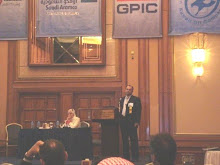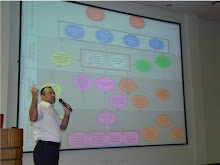Successful Project Management Office (PMO)
There was a global study conducted on 750 Project Management Offices (PMOs) which found that the most successful PMOs were centralized to service the entire organization and they provided added convenience to the project team at the same time (Stanleigh, 2006). To be successful, ten so called ‘secrets’ are recommended. These are:
1. Launch slowly and with careful project planning
2. Create scope statement and Project Plan to ensure a clear and successful, staged implementation.
3. Communicate regularly both internally and with the rest of the organization to garner on-going support from the senior management team.
4. Share and act upon lessons learned, providing regular feedback with/from stakeholders.
5. Effectively manage changes
6. Develop a “stage-gate” approval process for longer-term projects.
7. Simplify methodologies and implement them gradually.
8. Focus on training, mentoring and leading by example.
9. Implement scaleable processes and a simple reporting system to validate compliance with the project management process.
10. Establish project success measures to provide senior management with relevant information for decision-making affecting project completion.
Governance, consistency, quality and transparency are among the PMO benefits. These reflect on project outcomes and organizational revenue.
Another way to look at successful PMO as suggested by Wood (2008) is by identifying common weaknesses that PMO address in organizations, among those:
limited capital and resources
Lack of people dedicated to projects
Lack of objective methods to accept/cancel/terminate projects
Most project managers are really project administrators.
Most project estimates are too optimistic
For a PMO to effectively close these gaps, and be successful, it should:
1. Provide project administration support to project managers.
2. Justify projects based on “worst-case scenarios” in terms to budget, effort levels and completion dates.
3. Deploy standardized techniques and tools for estimating, reporting and project conduct. 4. Streamline paperwork.
4. Make project owners accountable for success of the project.
5. Turn project managers into project execution logicians.
6. Develop a repository of project templates, checklists and expert resources.
7. Adopt a “Once Started-Never Stopped” policy on approved projects
8. Limit the number of tasks that can be active to a person at any given time.
9. Deploy a pragmatic methodology for evaluating, approving and prioritizing projects.
It is important to distinguish the roles of Project Managers from that of a PMO member. Especially when some project managers have dual responsibilities. Therefore, the same PM may have to play a PMO role in some places and PM roles in another. Key identification of each of these roles is shown below. The PMO and the project manager roles are obviously different, but both of them are necessary to ensure the success of the individual project and the success of the overall portfolio of projects.
Finally, it is worth mentioning that it is a challenge to establish and maintain PMO. There is a considerable expenditure expected here and high risks as well. Failing to realise PMO benefits may lead to a state which is worse than the initial one. In my opinion, the following factors should be thoroughly studied at the outset:
• Expected roles of PMO
• Level of formality, authority, and desired structure
• Should the PMO be temporary or permanent
• Should it be built in-house or should we call external consultants/expertise
About The Author

- Eng. Samer el Barakeh, MPM, PMP
- Samer el Barakeh was born in Lebanon, 1973. He completed his Bachelor in Engineering-CCE at Beirut Arab University-Lebanon in 1996 with honours. Samer was granted Masters Degree in Project Management (MPM) from the University of Sydney-Australia with honours. He also gained the Project Management Professional (PMP) Credential from The Project Management Institute (PMI). Samer is a member of the Order of Architects and Engineers in Lebanon since 1996, The Project Management Institute (PMI), Arabian Gulf Chapter (AGC-PMI) and Lebanon Chapter-PMI. During his 13 years of professional experience in Lebanon, Australia and Saudi Arabia, Samer held many positions among them: Telecommunication Site Engineer, Site Manager, Low Current Service Head, and he is currently Senior Systems Analyst at the General Project Construction Division. Samer is a Project Management Consultant and Training Provider for universal organizations like Business Management Consultants (USA) www.bmc-online.com and PMCTQuest (Canada) www.pmctquest.com Samer is a Registered Training Provider for Project Management Professional (PMP), and he provides training in Program Management, Portfolio Management,PMO...
Select a topic to view content
- A comparison between PMBOK and Prince2 Methodologies and reflection on case study examples (1)
- ABC to Avoid Project Failure (1)
- Business Case and Quantitative Benefits (1)
- Do we need more 'Planners' ? (1)
- Fasilitator in Partnering-A Coincise Shot (1)
- How to Ensure Stratgic Alignment of Our Projects? (1)
- Individual Dissimilarity and Team Work (1)
- Knowledge Management (1)
- Maturity Models-The Pros and Cons (1)
- Organizational Advantages from Partnering (1)
- Organizational Maturity: Lets Head Upwards... (1)
- Organizational Strategy and Project Alignement (1)
- Practical Solutions 1 of 6: Introduce RMMM (1)
- Practical Solutions 2 of 6: Facilitate Change to Perk up Maturity (1)
- Practical Solutions 3 of 6: Leverage Organisational Culture Barrier (1)
- Practical Solutions 4 of 6: Organisational Cultural Alignment (1)
- Practical Solutions 5 of 6: Defining a Unified Decision Making Tool (1)
- Practical Solutions 6 of 6: Understanding The Paradox of Control (1)
- Programme Management to Implement Strategy (1)
- Project Management and Construction Management (1)
- Project Managers relocated before Proper Project Closure and Learning Lessons (1)
- Project Managers' Power (1)
- Strategic Planning (1)
- Successful Project Management Office-PMO (1)
- System Thinking: Archetypes at Work... (1)
- The Partnering Change Process (1)
- The Upper Hand… Leadership skills or Processes? (1)
- Thinking about change needed? Maybe you should be more ‘worried’ about how to make it real (1)
- Vision Mission and Objectives What and Why? (1)
- What is meant by Portfolio and Programme Management (1)
- Why Partnering in Organizations? (1)
April 27, 2008
Successful Project Management Office (PMO)
Posted by
Eng. Samer el Barakeh, MPM, PMP
at
7:36 PM
1 comments
![]()
![]()
April 14, 2008
Business Case and Quantitative Benefits
Should a business case be formal, justifiable, and in Dollar value/financial figures?
why do some organizations initiate projects without objective business cases?
Portfolio management and strategic planning are methods that lend the importance of a specific project business case towards the overall benefit of the portfolio or the programme of projects. In this aspect, a project with an ‘unjustified’ business case especially from the financial perspective can be accepted and implemented because it enables the realization of higher level organizational benefits.
This approach leads to less emphasis on formal business case development or using preset weighting systems for each project based on financial and objective criteria. Instead of objectively considering the dollar value and the grabbed opportunities (pros) along with the ‘opportunity cost’ of taking this project (cons), then making a conscious decision; I see that this approach would open a window for subjective decisions and executive powers to be the basis of decisions made to promote or exclude certain projects.
In some cases, the business case can be as big as a project by itself. It is sound practice to do so according to project size, complexity, etc. and of equal importance, when the project is to be managed in a stable surrounding. However, I believe that the importance of having a highly detailed business case in some competitive or rapidly changing environments can decrease significantly. This is due to having more qualitative factors that make it a challenge to have them ‘weighted’ quantitatively; and circumstances upon which a business case is based would change rapidly.
Agility, multi-phasing, decision gate review, flexible objectives and less formal business cases can be options to look at in this case.
In fact, this topic would promote the importance of establishing a PMO that should balance the formality and importance of business cases and ensure that only the right projects are accepted and pipelined. Furthermore, a key responsibility of PMO is to include the effect of ‘time’ and the rapidly changing environment and promote, terminate, or realign projects accordingly in order to stay in phase with the organizational strategic objectives. These strategic objectives would in-turn be changing!
Regards,
Samer
Posted by
Eng. Samer el Barakeh, MPM, PMP
at
9:09 PM
0
comments
![]()
![]()
April 7, 2008
Project Managers' Power
Once an organization structure is decided and established, the lines of authority can be drawn. But the interaction between organizational components, the shift in strategy along the way, and specific projects’ conditions would lead to continuous changes.
This is why two project managers, responsible for similar projects may have different authorities. And the same applies to functional divisions.
Estimating project managers may have more power, resources, and decision-making authority than some project managers these days… what? You may say… but yes, this is where a bottleneck may be today.
If we start with the organizational structure, matrix/functional etc…Having an established PMO or not, the culture of organizational members, their attitude towards power, and the complexity of projects, are all factors to consider when deciding on the level of authority ‘our project managers’ should be allowed to exercise.
Yes, I think that power should be ‘allowed’ and not given. We give an acceptable limit and different managers choose levels within these limits. PMO can close gaps by either supporting PMs or relocating them.
Our construction projects are huge. That is where other aspects of Project Manager’s power become of vital importance: Expert, Delegation, Referral, Coaching and the like. In our case, these sometimes prevail over the power ‘given’ by the PMO. Because, to manage complex projects, leadership becomes preferable over formal power. A ‘prisoner’s dilemma’ would cost a fortune.
Another aspect of looking into power is by looking at how much to “control”. I think that the PMO Heads/Strategic Decision makers /Executives can set high leverage points. Middle Management would draw more defined power control limits depending on specific situational conditions (as explained earlier). Their primary focus would be the strategic objectives and accordingly give more power in places that serve best. While on the lower level, Project Managers will be managing the implementation tools (Projects).
Posted by
Eng. Samer el Barakeh, MPM, PMP
at
10:20 PM
0
comments
![]()
![]()
Labels: Project Managers' Power
April 2, 2008
Portfolio and Programme Management
1. Introduction
In this posting, I would like to present a perspective for Programme and Portfolio Management and their integration. Additionally, different sights are presented on how Programme and Portfolio Management can be used to enable cultural change, strategic implementation, and maturity development.
To end with, a comment on other posting and some thoughts that are open for discussions.
2. Portfolio and Programme Management
Project Portfolio is when we have different projects for the whole organization belonging to different business units, departments, divisions that serve the overall organizational strategy.
Alternatively, when we have many projects for many clients managed as a portfolio of multi-projects that share a common resource pool but have independent outputs (Turner J.& Keegan A., 2001)
Programme is when we have very close projects like sub-projects or phases; many projects for one client are managed as a program of projects. They will contribute together towards the larger end and serve a main objective of satisfying the client. (Turner J.& Keegan A., 2001)
Integration, would we like to look at the bigger picture and integrate both, we can say that: “Portfolio Management is a set of whole-of-organization processes designed to give a complete, end-to-end view of all the programs and projects an organization is running or plans to run.”(Knapp & Moore, 2003)

3. To facilitate cultural change
Among the hardest to manage is the culture that resides within the organization. How about when it comes to planning and implementing cultural changes?
In fact, cultural change programmes should always be a corner block in the organizational portfolio of projects; especially since cultural change is a very slow and continuous process.
4. A wheel for strategic implementation
To make sure that the high level ‘mission statement’ is the umbrella that all projects reside under.
In order to overcome strategic implementation difficulties arising at corporate, business and operational levels, we use programme management as the strategic implementation “wheel” underpinned by relevant skills and established learning; not relying on projects with inappropriate systems/processes; which is a common mistake leading to diffused, diluted, compromised or postponed strategic implementation (Kippenberger, 2000)
An approach that I find really interesting and challenging is when a separate temporary structure can be created by developing integrated programmes of projects (Partington,2000) thus strategic change will be managed outside existing culture in a way to integrate projects and business as usual (Murray-Webster et al, 2000).
5. Portfolio for maturity development
Since closing many gaps in performance needs to be achieved before we can realize the maturity benefits, and since maturity gaps in specific areas would most probably affect outcomes from other areas that may be mature enough; Porgrammes of projects become effective means to ensure that the benefits realized exceed the sum of individual project benefits
6. Feedback on other Postings
I like the term presented that Portfolio Management is a ‘dialogue between business management of the organization and the implementation management …”. Although I would like to stop quoting here to maintain a loose end. Then think of how many dialogues can the organization have through portfolio management. Business? Strategic? Cultural development? Cultural alignment? Business and IT alignment? Competency development? Technical development? Alliance? Maturity development? Exploring new markets? Middle Managers’ Feedbacks?
I am not sure about the cost disadvantage of Portfolio and Programme Management. In this aspect, I would like to differentiate between performing the previously mentioned and establishing a PMO.
In matrix Organizations, Portfolio and Programme management provide high ROI once a PMO is established. PMOs will provide the infrastructure of centralized information (projects performance, future forecasts and strategic alignment, IT infrastructure and expertise ) that would enable easier and cost effective implementing of Portfolio/Programme Management…
If I was to look for some disadvantages of Portfolio/Programme Management, how about suggesting that they somehow promote the top-down approach, obstruct creativity among middle managers, and sometimes hinder organizational flexibility to explore and grab ‘opportunities’. However, these disadvantages can be minimized by feedback loops and by pushing strategic decision making lower into the hierarchy.
Regards
Samer
Posted by
Eng. Samer el Barakeh, MPM, PMP
at
8:08 PM
0
comments
![]()
![]()
















